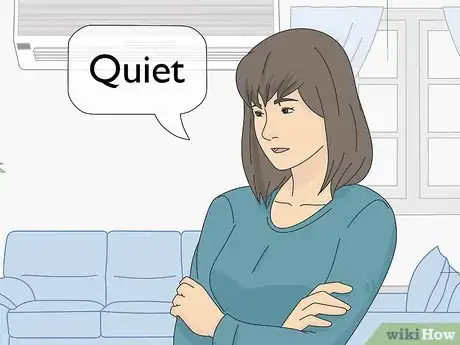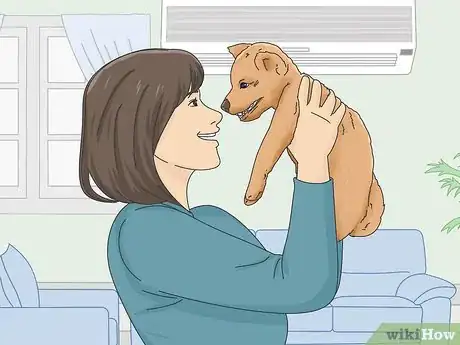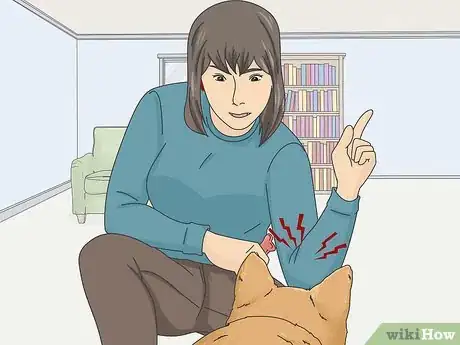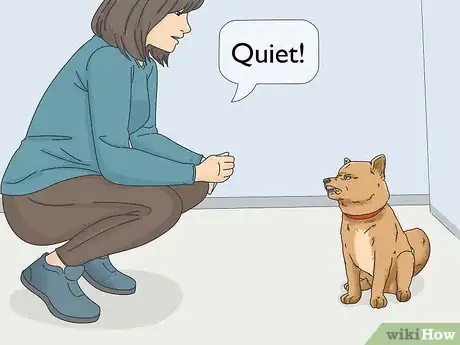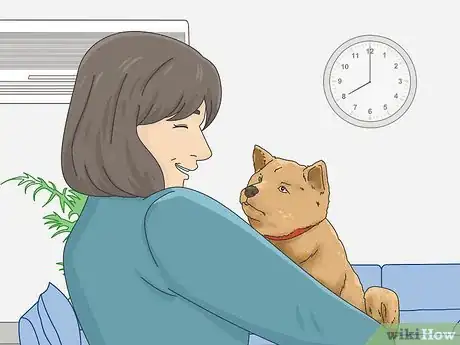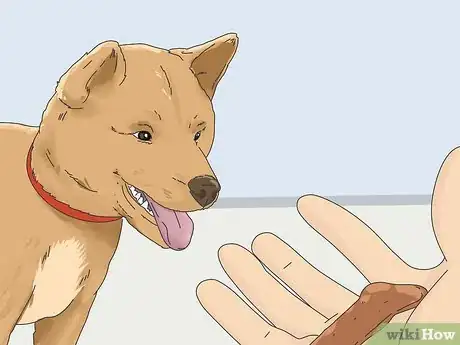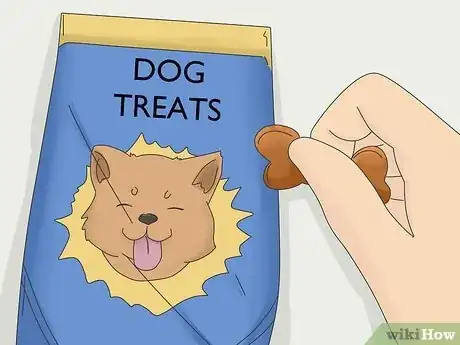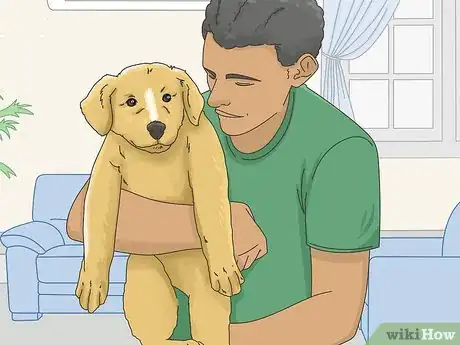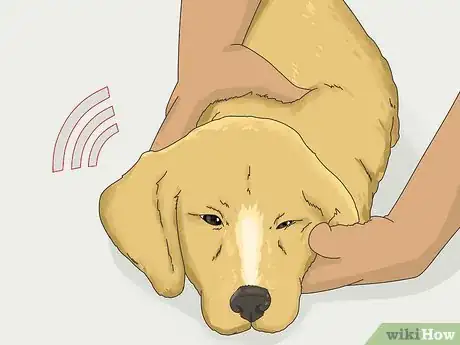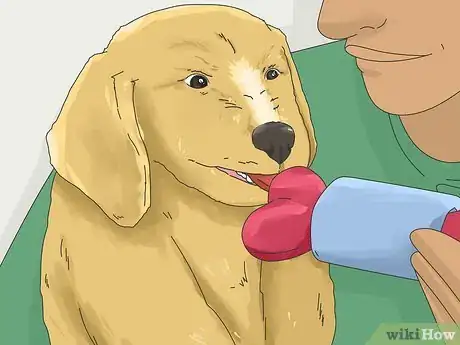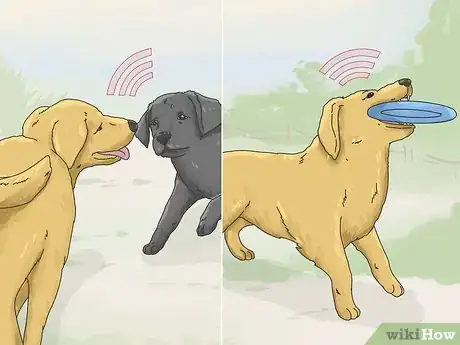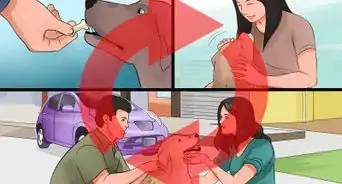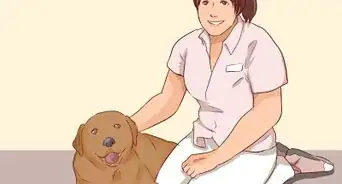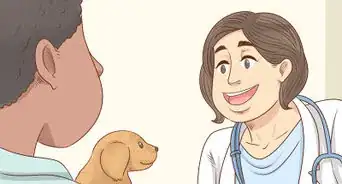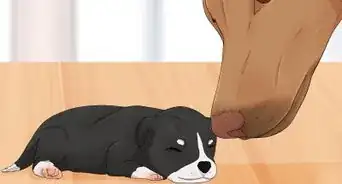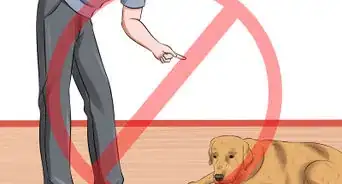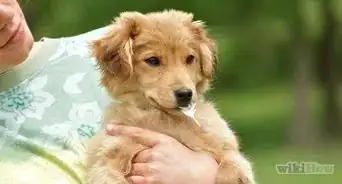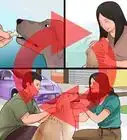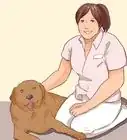This article was co-authored by David Levin. David Levin is the Owner of Citizen Hound, a professional dog walking business based in the San Francisco Bay Area. With over 9 years of professional dog walking and training experience, David's business has been voted the "Best Dog Walker SF" by Beast of the Bay for 2019, 2018, and 2017. Citizen Hound has also been ranked #1 Dog Walker by the SF Examiner and A-List in 2017, 2016, 2015. Citizen Hound prides themselves on their customer service, care, skill, and reputation.
wikiHow marks an article as reader-approved once it receives enough positive feedback. In this case, 100% of readers who voted found the article helpful, earning it our reader-approved status.
This article has been viewed 308,091 times.
Is your cute little puppy growling at you when you pick him up? Is this growling concerning enough that you fear he’s going to become an aggressive dog when he’s an adult? Almost every puppy goes through a growling stage. Just because a puppy growls at you does not mean he does not like you or is becoming aggressive. However, growling at you should not be tolerated, and you should take action to stop it. You can help your puppy learn to curb his growling and become a good-mannered puppy in the process.
Steps
Using Positive Reinforcement
-
1Research positive reinforcement. The best way to teach your puppy a command or to teach your puppy that certain behaviors are not acceptable is through positive reinforcement. This simply means praising appropriate behavior instead of attempting to punish inappropriate behavior. You can weed out improper behavior by giving your puppy motivation to behave in the ways that he know will get him praise and treats.[1]
-
2Choose a command. One of the most important aspects of training via positive reinforcement is consistency since your puppy will only understand through repetition. The first thing to be consistent about is the word you use to communicate to your puppy that you want him to stop growling. “Quiet” is the most common phrase for this.[2]
- Once your puppy understands the meaning of “quiet,” you can also use this command for inappropriate barking, whining, and other vocalizations.[3] Always ensure that the puppy isn’t actually vocalizing for good reason before issuing the command.
Advertisement -
3Provide treats and praise when you pick the puppy up. If the puppy doesn’t start growling as soon as you pick him up, then provide verbal praise by telling him he’s a good boy in a soft voice. You should also keep several small pieces of treat in your pocket and give him a nibble-size bite of treat while he remains quiet and docile as you hold him.[4]
- To ensure that you’re not giving puppy too much in the way of treats as you train, use very small pieces—pea-sized even.[5]
-
4Stop providing treats if he starts growling. You want the puppy to begin associating the treats with the quiet, calm behavior he shows when you hold him. As soon as the puppy starts growling, stop giving him praise and treats. However, do not put him down. If you also put the puppy down when he starts growling, then he’ll begin associating growling with you putting him down, which will only strengthen the behavior instead of eliminating it.[6]
-
5Use your chosen command. If you’ve chosen “quiet” as the command, use it now after you’ve stopped giving the puppy treats.[7] Use a stern tone but not one that is loud or so aggressive that it will scare the puppy. If you issue the command in a soft tone, then the puppy will only think it’s more praise since that’s the same tone you use for the positive reinforcement.
- Only use the command once and then wait for the puppy to stop. Repeating the phrase over and over will only make it harder for the puppy to associate it with the desired behavior.
-
6Provide more praise and treats when the puppy stops growling. As soon as the puppy stops growling for several seconds, provide more praise and treats.[8] You may have to wait a minute for the puppy to give up on the growling behavior, but give him more treats and praise as soon as he stops. It won’t happen immediately, but the puppy will begin to understand after days (or weeks) or repetitions that you’re pleased and give small treats when he’s quiet while being held and that all of that positive reinforcement ceases when he growls.
-
7End on a good note. Always end on a moment of positive reinforcement. Though you may have to wait for the puppy to stop growling even when you yourself are ready to put him down, always end the training sessions on moments of positive reinforcement. Wait for the puppy to stop growling, give him the praise and treats, and then finally put him back down.
- To help avoid too much reliance on treats, you can also use other forms of positive reinforcement. For instance, when you’re ready to put the puppy down, wait for him to stop growling and then offer him praise and immediately give him his favorite toy to play with when you set him down.
-
8Show consistency. Puppies will only learn the behavior if you show extreme consistency in providing and taking away the positive reinforcement. Mixed messages does not work in puppy training.[9] Be diligent when it comes to providing the puppy with praise, treats, and his toys for displaying the proper behavior.
- This means that everyone in the household has to do their part in the training process as well. Your puppy won’t learn if you’re the only one trying to teach. Ensure that everyone who handles the puppy uses the same process of providing positive reinforcement.[10]
-
9Have patience. Some puppies may catch onto the command after only a few repetitions, whereas other puppies may need weeks to catch on. Have patience because with consistency, the puppy will eventually learn.
- Never get so frustrated that you scold or swat the puppy. Dogs understand when you’re angry at them but rarely why you’re angry, so punishments can confuse your dog. Stick with positive reinforcement.
-
10Reduce the dependence on treats. As your puppy learns what behavior you expect of him when he’s held and when you issue the “quiet” command, you can reduce the frequency at which you provide treats for obedience. While you should decrease the dependence on treats, always continue remaining consistent with other forms of positive reinforcement, especially praise.[11]
- Initially, provide a treat four out of every five times that your puppy obeys and displays the correct behavior. As he begins responding regularly to the “quiet” command, then reduce to three out of five times and continue reducing at slow intervals. When your puppy fully understands and consistently obeys all the time, you can reduce to only providing an occasional treat.[12]
- Vary the reinforcement schedule. Your puppy is smarter than you may realize, and he’ll catch on if you consistently provide treats every other time, which can lead to him only obeying every other time. Use a schedule that’ll keep him trying to please you and receive his treats.[13]
Taking Additional Steps for Success
-
1Hold the puppy properly. Your puppy may simply be growling because he doesn’t like the way you pick him up or because you hold him in an uncomfortable manner. Though common, puppies do not like being picked up under the arms and lifted that way. It can even hurt the puppy.
-
2Pay attention to the frequency of the growling. If your puppy is growling at everyone, then consider that he just might not like being picked up. Dogs are meant to be running around and exploring. It is not natural or normal for dogs to be carried and the puppy might feel uncomfortable being handled in this way. It may be more of a fearful reaction at the situation than an aggressive reaction.[16]
-
3Deflect the behavior with a toy. If your puppy is fine with you picking him up but begins growling shortly after, then you can deflect the behavior with a toy. Ensure that you give the puppy the toy before he starts growling. Otherwise he can mistake the toy as a reward for the growling.
- A toy is also a good way to deflect a puppy that is too mouthy—playfully bites at your arms or hands—when you pick him up.
-
4Differentiate playful growling in other areas. Your puppy will likely growl at other times in addition to when you pick him up. He may growl when playing with other puppies, when playing with toys, etc. Growling during play is normal, and you may not want to “quiet” the puppy during these moments. If your puppy is bouncing around, has a playful expression with his mouth open, and “play bows”—bounces down into a position with his front paws down and his rear end in the air—then he’s simply playing and not trying to shown real aggression or dominance.[17]
- Dogs growling to express aggression or dominance are much more likely to stare directly at the source, have ears back, and mouths tight—possibly while baring their teeth.[18] Aggressive growling will also be accompanied by a dog that’s holding very still and is focused.
- If your puppy ever growls when someone else approaches him as he eats, then he’s showing signs of food-related aggression. Contact a certified animal behaviorist in your area to help eliminate aggressive behavior related to food.[19]
-
5Consider seeing a professional trainer. If after several weeks of training, your puppy still hasn’t gotten the hang of the command and still growls, then look into professional training. A trainer will examine how you’ve been issuing the command and correct any inconsistencies that may be confusing your puppy.
Expert Q&A
Did you know you can get expert answers for this article?
Unlock expert answers by supporting wikiHow
-
QuestionWhy is my puppy growling when I pick her up?
 David LevinDavid Levin is the Owner of Citizen Hound, a professional dog walking business based in the San Francisco Bay Area. With over 9 years of professional dog walking and training experience, David's business has been voted the "Best Dog Walker SF" by Beast of the Bay for 2019, 2018, and 2017. Citizen Hound has also been ranked #1 Dog Walker by the SF Examiner and A-List in 2017, 2016, 2015. Citizen Hound prides themselves on their customer service, care, skill, and reputation.
David LevinDavid Levin is the Owner of Citizen Hound, a professional dog walking business based in the San Francisco Bay Area. With over 9 years of professional dog walking and training experience, David's business has been voted the "Best Dog Walker SF" by Beast of the Bay for 2019, 2018, and 2017. Citizen Hound has also been ranked #1 Dog Walker by the SF Examiner and A-List in 2017, 2016, 2015. Citizen Hound prides themselves on their customer service, care, skill, and reputation.
Professional Dog Trainer Understand when your puppy growls because it wants to be left alone. It's important to allow dogs their own time to enjoy their space or relax, although you have to balance that with ensuring they're submissive to your touch. Approach the situation empathetically, and ask yourself if it's important to pick up the dog now, or if it can wait. Touch should be a rewarding experience for your puppy, which will help desensitize it.
Understand when your puppy growls because it wants to be left alone. It's important to allow dogs their own time to enjoy their space or relax, although you have to balance that with ensuring they're submissive to your touch. Approach the situation empathetically, and ask yourself if it's important to pick up the dog now, or if it can wait. Touch should be a rewarding experience for your puppy, which will help desensitize it. -
QuestionWhat are signs of aggression in puppies?
 Pippa Elliott, MRCVSDr. Elliott, BVMS, MRCVS is a veterinarian with over 30 years of experience in veterinary surgery and companion animal practice. She graduated from the University of Glasgow in 1987 with a degree in veterinary medicine and surgery. She has worked at the same animal clinic in her hometown for over 20 years.
Pippa Elliott, MRCVSDr. Elliott, BVMS, MRCVS is a veterinarian with over 30 years of experience in veterinary surgery and companion animal practice. She graduated from the University of Glasgow in 1987 with a degree in veterinary medicine and surgery. She has worked at the same animal clinic in her hometown for over 20 years.
Veterinarian
-
QuestionIs it normal for a puppy to growl at you?
 Pippa Elliott, MRCVSDr. Elliott, BVMS, MRCVS is a veterinarian with over 30 years of experience in veterinary surgery and companion animal practice. She graduated from the University of Glasgow in 1987 with a degree in veterinary medicine and surgery. She has worked at the same animal clinic in her hometown for over 20 years.
Pippa Elliott, MRCVSDr. Elliott, BVMS, MRCVS is a veterinarian with over 30 years of experience in veterinary surgery and companion animal practice. She graduated from the University of Glasgow in 1987 with a degree in veterinary medicine and surgery. She has worked at the same animal clinic in her hometown for over 20 years.
Veterinarian
Warnings
- Do not let young children pick a puppy up because if they drop him, the fall could injure the puppy. Also, if your puppy does growl and bite, then you don't want your child to become afraid of the puppy. If you do let them hold the puppy, make sure they are sitting down with supervision.⧼thumbs_response⧽
References
- ↑ http://www.humanesociety.org/animals/dogs/tips/dog_training_positive_reinforcement.html
- ↑ Canine and Feline Behavior for Veterinary Technicians and Nurses. Edited by Julie Shaw and Debbie Martin. John Wiley & Sons, Inc. 2015
- ↑ https://www.aspca.org/pet-care/virtual-pet-behaviorist/dog-behavior/barking
- ↑ Canine and Feline Behavior for Veterinary Technicians and Nurses. Edited by Julie Shaw and Debbie Martin. John Wiley & Sons, Inc. 2015
- ↑ http://www.humanesociety.org/animals/dogs/tips/dog_training_positive_reinforcement.html
- ↑ Canine and Feline Behavior for Veterinary Technicians and Nurses. Edited by Julie Shaw and Debbie Martin. John Wiley & Sons, Inc. 2015
- ↑ Canine and Feline Behavior for Veterinary Technicians and Nurses. Edited by Julie Shaw and Debbie Martin. John Wiley & Sons, Inc. 2015
- ↑ Canine and Feline Behavior for Veterinary Technicians and Nurses. Edited by Julie Shaw and Debbie Martin. John Wiley & Sons, Inc. 2015
- ↑ http://www.humanesociety.org/animals/dogs/tips/dog_training_positive_reinforcement.html
- ↑ http://www.humanesociety.org/animals/dogs/tips/dog_training_positive_reinforcement.html
- ↑ http://www.humanesociety.org/animals/dogs/tips/dog_training_positive_reinforcement.html
- ↑ http://www.humanesociety.org/animals/dogs/tips/dog_training_positive_reinforcement.html
- ↑ http://www.humanesociety.org/animals/dogs/tips/dog_training_positive_reinforcement.html
- ↑ Handbook of Applied Dog Behavior and Training, Procedures and Protocols. Volume 3. Steven R. Lindsay. Blackwell Publishing. 2005
- ↑ Handbook of Applied Dog Behavior and Training, Procedures and Protocols. Volume 3. Steven R. Lindsay. Blackwell Publishing. 2005
- ↑ Handbook of Applied Dog Behavior and Training, Procedures and Protocols. Volume 3. Steven R. Lindsay. Blackwell Publishing. 2005
- ↑ https://www.aspca.org/pet-care/virtual-pet-behaviorist/dog-behavior/canine-body-language
- ↑ https://www.aspca.org/pet-care/virtual-pet-behaviorist/dog-behavior/canine-body-language
- ↑ https://www.aspca.org/pet-care/virtual-pet-behaviorist/dog-behavior/food-guarding
About This Article
To get a puppy to stop growling when you pick it up, reward it every time it doesn’t growl to reinforce its good behavior. For example, if your puppy is quiet when you pick it up, give it verbal praise and feed it a small treat. Alternatively, if your puppy starts growling, say something like “Quiet” in a stern voice. As soon as it stops growling, go back to giving it praise and another small treat. Use this technique consistently, and be patient, since it may take time and repetition to change your puppy’s behavior. For more tips from our Veterinary co-author, like how to wean your puppy off the treats once the growling stops, read on!

